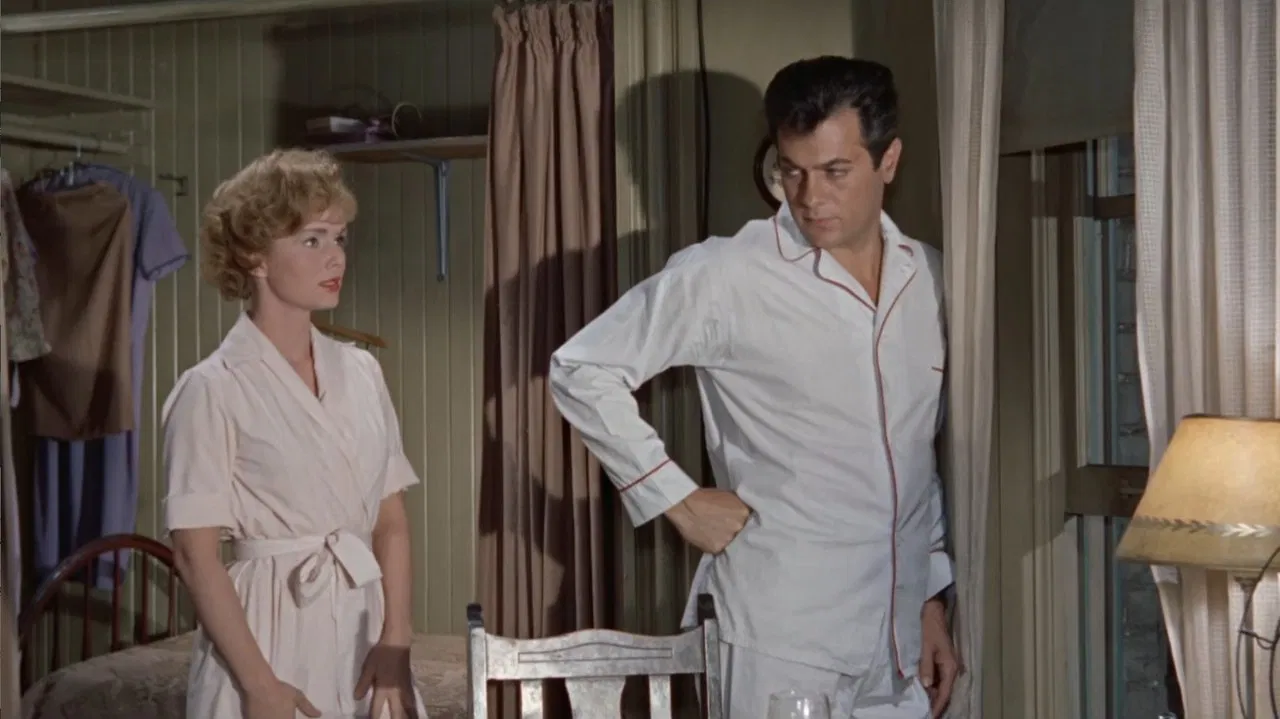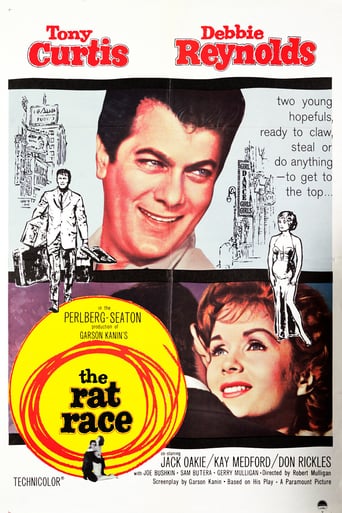

An ambitious jazz musician tries to make it in The Big Apple despite hardships. Meanwhile he befriends a desperate taxi dancer trying to hold on to her self-respect.The 105-minutes amounts to a sour valentine to New York City. The ending is predictable from the start. Why else cast two big Hollywood stars in the leads. The fact that Peggy (Reynolds) and Pete (Curtis) finally get together is not because of the City, as we might expect, but in spite of it. Thus the screenplay breaks with Hollywood convention of big cities with a soft heart. Note, for example, how the landlady's morning grouch gets quickly reflected in other grouchy New Yorkers.. That sort of uncompromising attitude may be the movie's best part. Otherwise, it's Reynolds breaking with her malt shop image, as a hard case who registers zero smiles throughout. At the same time, the effort to break with the Tammy image (Tammy And The Bachelor, {1957}) is too pointed and resolute to be convincing. Curtis, on the other hand, is fairly amiable, and not quite as miscast as Reynolds. Still, his Bronx accent sort of comes and goes for a guy supposedly from Milwaukee. Having two stars at the peak of popularity also means giving them adequate screen time to satisfy their fans. But that also means padding a slender storyline with lots of talk that too often drags out the runtime. Note too, how awkwardly the script plays with the key topic of prostitution, a word or even concept that dare not speak its name, thanks to the suffocating Production Code. Anyway, Oakie and Medford supply subtle amusement, while Rickles chews the scenery like he's starving for attention. All in all, it's a 105-minutes that doesn't wear well, despite being cutting edge at the time. All in all, I'm glad that Reynolds soon went back to the personality roles she was so good at.
... View Moreif you're thinking of Tony Curtis and Debbie Reynolds with their Hollywood glamor - you're in for quite a surprise - this is grittier stuff than they usually did - altho - not guttery or depressing - as it would be in todays milieutry to overlook the residue of Tonys Bronx accent - and enjoy his eager Midwestern saxophonist arriving in the jazz musicians mecca - Noo Yook Cityexcept he's not in a typical Hollywood success story - here the emphasis is on disillusionment - and its actually risqué for its time - with Tony and struggling dancer Debbie Reynolds sharing an apartment - both actors are very good - Debbie could have used more such rolesthe script is too talky perhaps - too much like a stage play - the most memorable thing for me beside the stars is the music - especially the throbbing theme song played over the opening scenes of Tony's cross country bus ride - from the plains of the Midwest - to smog shrouded NYCand i can still hear in my mind the driving version of THAT OLD BLACK MAGIC played with real life saxophonists Sam Butera and Jerry Mulligan - and Joe Buskin at the keys - that scene demonstrates how convincing Curtis was at faking playing a saxophone - notice his red face while playing the large baritone sax - when i was in the school band - i could barely get a sound out of one of them
... View MoreMidwestern saxophonist Tony Curtis (as Pete Hammond Jr.) arrives in New York City, seeking fame and fortune. Instead, he finds himself lost in "The Rat Race". Mr. Curtis quickly meets disillusioned Debbie Reynolds (as Peggy Brown). Ms. Reynolds works as a paid dancing partner, for sailors and other lonely men. The two decide to pool their resources by sharing an apartment, agreeing to a platonic living arrangement. The roommates frequent the local watering hole, and hear older, wiser owner Jackie Oakie (as Mac) and landlady Kay Medford (as Soda) dispense words of wisdom. Curtis loses his musical instruments. Then, Reynolds loses her job. Will Curtis and Reynolds gain romance? Robert Mulligan's version of Garson Kanin's play, which starred Barry Nelson and Betty Field, never really takes off. Curtis and Reynolds (and the film, generally) look way too sharp to be Mr. Kanin's desolation row denizens, clawing their way to the top. Don Rickles is a highlight, as Reynolds' brutal, sadistic boss. Norman Fell is amusing, as the telephone man. Reynolds is unexpectedly glamorous, almost more suited for the lead in "Butterfield 8"; and, she looks especially sexy undressing for the lecherous Mr. Rickles. ***** The Rat Race (7/10/60) Robert Mulligan ~ Tony Curtis, Debbie Reynolds, Don Rickles
... View MoreIf Garson Kanin's stage version were successful enough to earn a movie treatment by producers Perlberg and Seaton, whose adaptation of Clifford Odets's "The Country Girl" is famously exquisite, one can only assume that the play was more honest and less preposterously disingenuous than this laughable adaptation.Written by Kanin himself, who must have swallowed a fair amount of bile at the bowdlerizing mandated by the Hollywood Production Code, the film addresses its central question, which appears to be whether "dance hall girl" Debbie Reynolds (!) is or isn't a prostitute, with pages and pages of jaw-droppingly elliptical dialogue that bears no resemblance to human speech -- lines on the order of, "I'd never think you'd...you know..." and "How could you think I'm the kind of girl you think I am?" Those are not necessarily exact quotes, but you get the idea.The film is sunk by other equally bizarre choices at every turn, including not only the female lead's spectacular miscasting but her co-star's as well. Presenting Tony Curtis as a Midwestern naif being conned by heartless Manhattanites produces such howlingly funny utterances as "And on my foist day in New Yawk!" '30s Paramount comedy star Jack Oakie and Kay Medford, Dick Van Dyke's mother in the stage version of "Bye, Bye, Birdie," comprise a kind of greasy-spoon Greek chorus, a bartender and his only barfly, Reynolds's landlady, whom we first meet sitting at the bar drinking orange soda! In this Times Square saloon which, like many other sets in the film, reveals the art director's painful fascination with red walls, there is more mugging going on than in Central Park.But all of this is topped by the grotesquely overwrought, bug-eyed and nostril-flaring performance of Don Rickles, who quickly demonstrates why he found his true calling in standup rather than film acting. You're better off reading the play, but only reading it, because no impresario has the bad taste to mount a revival of it any more.
... View More